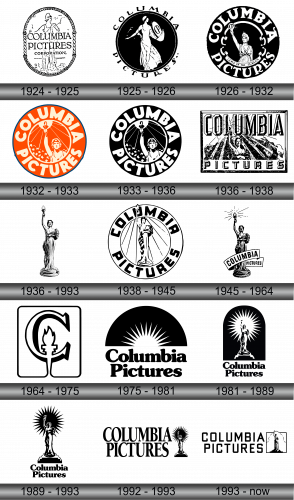Columbia Pictures Logo
Columbia Pictures, an esteemed name in the entertainment realm, operates as a key film production and distribution entity. Currently, it delves into creating a mix of blockbusters, independent films, and television content. Predominantly active in global markets, the US remains its principal arena. A significant subsidiary of Sony Pictures Entertainment, its ownership traces back to the larger conglomerate, Sony Corporation. Over the years, Columbia has solidified its stature as a pivotal player in Hollywood, continuously shaping cinematic experiences for audiences worldwide.
Meaning and history
Founded in 1918 by Harry and Jack Cohn along with Joe Brandt, Columbia Pictures began as CBC Film Sales Corporation. From modest beginnings, selling short films, the company quickly transitioned into feature-length productions by the 1920s.
The 1930s saw Columbia rising from a minor player to a major studio with hits like “It Happened One Night”. Despite its success, Columbia was often perceived as less prestigious than its peers.
Post-WWII, Columbia further solidified its position with classics like “On the Waterfront”. As the studio system declined, Columbia adapted, pioneering independent film production deals.
Ownership shifts started in the 1980s. In 1982, the company was purchased by Coca-Cola. This period witnessed a focus on television production and collaboration with promising directors. However, by 1989, Sony Corporation acquired Columbia Pictures for $3.4 billion, integrating it into Sony Pictures Entertainment.
Under Sony’s umbrella, Columbia thrived, producing numerous box office hits. Its library expanded with acquisitions like the Metro-Goldwyn-Mayer movie catalog. The 2000s and beyond saw Columbia capitalizing on franchises and collaborating with renowned filmmakers.
Today, as a subsidiary of Sony, Columbia Pictures continues its legacy, marrying cinematic tradition with innovation, and influencing global film culture.
1924 – 1925
Prior to adopting its current designation, the film production house was known as CBC Films. Its solitary emblem, crafted in 1918, bore the abbreviation CBC, an homage to the Cohn siblings and Joe Brandt, its visionaries. This primary insignia showcased “CBC” in uppercase, cast in a robust traditional font with subtle flourishes gracing letter terminals. Below it, “Film Sales Corporation” was inscribed, distinguished by the elongated, decorative flourish of the “R”, elegantly arching over “New York” scripted below.
In 1924, a rebranding initiative led to the christening of Columbia Pictures. Its inaugural emblem presented a Roman sentinel, a shield wielded in one hand and a sheaf of wheat in the other. This pictorial element was enveloped by an elliptical seal, where the brand’s name spanned the central portion, overlaying the figure. This medallion was accentuated by an intricately detailed border, flanked by Grecian pillars, adding a touch of classical elegance to the overall design, emphasizing the company’s rich heritage and ambition.
1925 – 1926
In 1925, the emblem underwent a significant transformation, evolving with the times. The backdrop was changed to a deep black, and the outlines of the design were accentuated, imbuing it with greater boldness and assurance. Instead of its previous shape, the symbol now took on a circular form. Surrounding this round motif, the brand’s name was thoughtfully positioned, encircling it from the exterior. This revamp not only reflected the contemporary aesthetic of the era but also emphasized the brand’s commitment to progress and staying updated with changing tastes. It was evident that the company desired a distinctive identity, marrying the past with the present, ensuring that their brand remained memorable and relevant for the audience.
1926 – 1932
The inception of the Columbia Lady, grasping a beacon of light in her hand, marked a pivotal moment in the company’s branding history. This illuminating concept, symbolizing hope, guidance, and inspiration, was first introduced through this particular logo. Over the years, as the company evolved, so did the representation of the iconic lady. Though her basic essence remained intact, various iterations saw her depicted in diverse nuances and subtleties. This enduring motif not only captures the legacy of the brand but also showcases its adaptability. The continuous usage and reimagining of the torch-bearing lady, in different avatars across the company’s logos, highlight its commitment to both tradition and innovation. It stands as a testament to the brand’s timeless appeal and its ability to resonate with generations while embracing change.
1932 – 1933
In 1932, the logo underwent another transformative revamp. The new design prominently featured the bold shade of crimson, lending it an eye-catching vibrancy. This choice of hue was complemented by meticulously crafted contours, giving the emblem a fresher, more avant-garde look. Radiating from the torch held by the lady, delicate white streaks contrasted brilliantly against the red backdrop, creating a dynamic visual effect. Furthermore, the accompanying wordmark was rejuvenated with a sleek, sans-serif typeface, encapsulating the modern sentiments of the era. This design evolution not only showcased the brand’s ability to stay ahead of the curve but also its knack for blending timelessness with contemporary flair. The logo stood as a paragon of design excellence for its generation.
1933 – 1936
In 1933, the logo made a stylistic pivot, reverting to a grayscale color scheme. However, the aesthetic foundation laid down in 1932 was preserved in its entirety. This switch to a black and white palette endowed the emblem with a heightened sense of gravitas and sophistication. The interplay of these two classic hues brought forth a commanding presence, subtly conveying an aura of dominance and leadership. The monochromatic approach, while seemingly simple, tapped into the deep-rooted associations we have with black and white: clarity, distinction, and timelessness. In embracing this palette, the brand showcased its maturity and its aspiration to be perceived as a benchmark in its field. This strategic design move underscored the company’s vision of combining tradition with modern sensibilities.
1936 – 1938
In that era, the emblem adopted a rectangular form. Positioned above the lady’s silhouette, the word ‘Columbia’ was prominently displayed. At the emblem’s pinnacle, ‘Pictures’ was inscribed, sitting at the utmost lower region, cast in a more diminutive typeface. This layout offered a balanced visual appeal, drawing attention to the central figure while ensuring both textual elements were discernible. The choice of positioning and font size provided an artistic hierarchy, making the design both elegant and functional, representing the brand’s identity and vision during that time. The overall composition encapsulated the company’s essence, intertwining legacy with innovation.
1936 – 1993
During this phase, the company’s emblem, representing its U.S. national heritage – a woman’s outline hoisting a torch aloft – achieved enhanced depth and dimension. The shimmering backdrop, seemingly emanating from the torch, enriched its visual appeal, making it more memorable than previous iterations. This iconic female was inspired by a real-life muse, the actress Evelyn Venable. While the subsequent years saw various tweaks to the design, the core essence of the emblem remained unchanged, ensuring that the symbol continually resonated with its audience, blending tradition with contemporary interpretations and encapsulating the brand’s enduring legacy.
1938 – 1945
The representation of the woman, holding aloft a torch, was expanded to depict her entire figure and was encased within a circle. This inner ring was itself encapsulated by a broader outer circle. Within the space separating these concentric rings, the company’s name was artistically split: the initial segment arched gracefully atop in bold uppercase, while the latter part found its place at the base. Both words were rendered in a harmonious black font, ensuring consistency in size and style, beautifully merging tradition with a touch of modern design, capturing the essence of the brand’s timeless legacy.
1945 – 1964
Significant modifications were introduced to the emblem. The depiction of the woman, poised atop a petite platform crafted in 1936, received intricate enhancements. Her torch emanated beams, artistically illustrated as rays stretching in varying lengths and directions. The brand’s moniker was inscribed on a sash that swirled from right to left, initially descending and then gracefully arching behind the woman, encircling her feet. ‘Columbia’ was boldly scripted on the sash’s forefront, while ‘Pictures’ graced the backdrop. The latter section of the ribbon, coupled with its typography, was rendered in a more diminutive scale, crafting an optical illusion of depth.
However, this rendition of the emblem underwent tweaks over time, enduring on screen until 1975. Its final cinematic appearance graced “Harry and Walter Go to New York”, marking an end of an era.
1964 – 1975
Conceived in 1964, the logo stood out as the epitome of minimalistic design throughout the company’s storied timeline. The emblem consisted of a refined rendition of the letter “C”, seamlessly integrated with a torch motif. The primary color used was a pristine white, while a contrasting black was employed to craft an outline and shadow, giving depth and a three-dimensional feel to the otherwise flat design. Surrounding this emblem was a subtle frame, a svelte square with gently curved corners. This pared-down approach highlighted the brand’s ability to convey its essence with understated elegance, marrying simplicity with sophistication. In a landscape often dominated by intricate designs, this logo was a testament to the adage, “less is more,” making a profound impact through its restraint and clarity.
1975 – 1981
In 1975, a transformative design emerged, marking a fresh chapter for the brand. This design featured a striking wordmark in deep black, arranged over two tiers, creating a visual hierarchy. Atop this textual element was a semi-circular symbol, harmoniously blending shades of black and white. This icon, at its core, showcased a modern interpretation of a torch, characterized by a series of intense, angular rays emanating outward. The entire ensemble exuded an aura of vibrancy, potency, and contemporary flair. With this renewed design, the brand confidently stepped into an era where boldness and style coexisted. The fusion of traditional elements with avant-garde aesthetics signified the brand’s adaptability and its keen eye for trends, ensuring its relevance in ever-evolving times.
1981 – 1989
During this era, there was a fervent quest for a refreshed identity. The company ceaselessly tinkered with its emblem. While Frankfort Communications’ design retained the iconic woman clutching a torch, there was a noticeable shift in the illumination it cast. This luminescence unfurled expansively behind her, forging a halo that framed her head and shoulders. This radiant circle, punctuated by equidistant conical beams, emitted a serene blue hue, dancing vibrantly on screen. Below this display, the enterprise’s moniker was etched in the distinct Souvenir typeface. For television adaptations, only the upper segment of this halo was showcased, colored in shades of fiery orange or deep red, accompanied by the label beneath. The modification aimed to provide a contemporary twist while preserving the emblem’s heritage.
1989 – 1993
The Columbia Pictures emblem experienced a vibrant transformation. Now, the iconic Lady bearing the Torch was illustrated with bold black lines, contrasting strikingly against a pristine white backdrop. The surrounding dark, rounded graphic evoked the essence of a radiant beam or perhaps emanating rays, adding depth and character to the design. While the typography underwent subtle tweaks to modernize and enhance its appearance, it retained the core design essence familiar from its predecessors. This refreshing take on the logo was a delicate dance between preserving tradition and embracing innovation. The contrasting palette not only highlighted the emblem’s iconic elements but also underscored the brand’s commitment to evolving while acknowledging its rich history.
1992 – 1993
This emblem served as a visual marker during the pivotal phase when Sony amalgamated both Columbia and Tri-Star, culminating in the formation of Sony Pictures Entertainment.
1993 – Today
The contemporary logo, which the company proudly displays today, took shape in 1993. It boasts an amplified wordmark, strategically segmented into two layers, with the emblematic symbol gracefully positioned to its right. This typographic element is crafted in a rigorous geometric sans-serif typeface. The square architecture of the characters, combined with the pronounced, robust lines, lends it an air of authority.
Diving deeper into the emblem, one finds a meticulously rendered representation of the legendary lady. This figure, while exuding subtlety, stands with undeniable strength. She’s encircled by a gracefully arching line, reminiscent of a cloud, weaving a narrative of dreams and aspirations. Encapsulating this scene is a rigid square boundary, adding structure and stability.
This design marvel masterfully merges tradition with modernity. It is a tribute to the company’s storied past, while simultaneously capturing its forward-thinking ethos. This logo stands not just as a brand identifier, but as an emblem of enduring grace and formidable presence, echoing the company’s rich legacy and ambition.


























